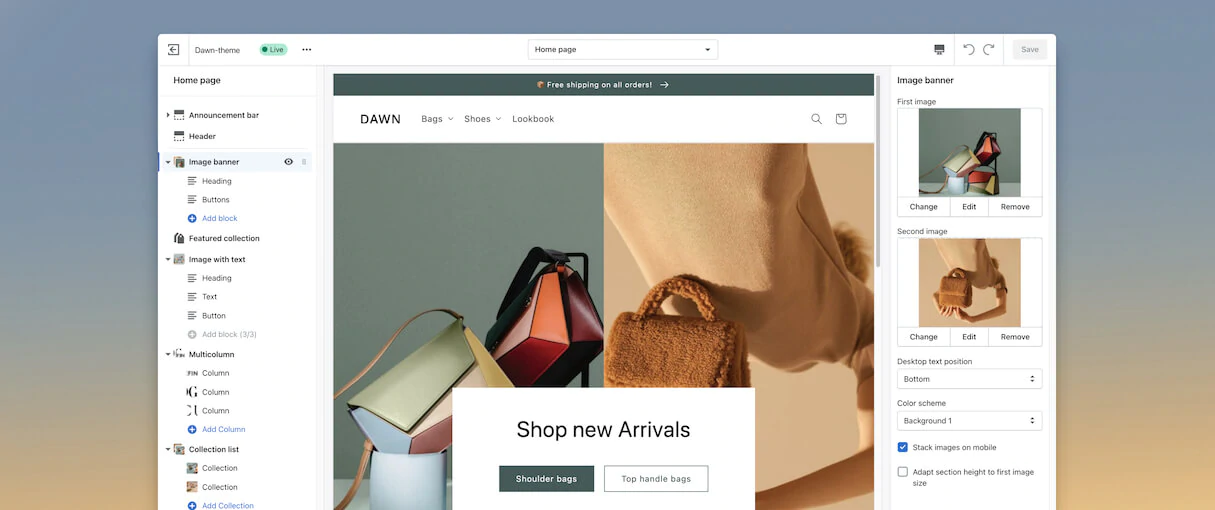
We expect each new software version to be better than the previous one. Shopify is no different. What changes have been made to this popular e-commerce platform?
Shopify 2.0 – why is it worth it?
The Shopify platform is known for its user-friendliness. It is aimed at small, medium and large enterprises.
Depending on the plan you choose, you have different tools at your disposal. Anyone can set up a store on Shopify, no programming knowledge is needed. Sales management is also very simple.
Because Shopify operates on a Software-as-a-Service (SaaS), or subscription model, you get access to the app as long as you pay a monthly or annual subscription. You can opt out and close your Shopify online store at any time. All this makes it a popular choice. Now, with the introduction of a number of improvements and new features in Shopify 2.0, merchants get new stores that are easier to build, that are also easier to maintain and have more flexibility. What exactly has been changed?
What changes has Shopify 2.0 brought?
Shopify Unite is an online event where Shopify developers present changes and new features that every Shopify online store can look forward to. June 2021 unveiled not only changes that optimize store management, but more importantly the biggest upgrade to date, Shopify 2.0. What did it bring? First of all, improvements have been made in editing the store layout, checkout and payments.

Changes to Shopify, version 2.0
Anyone with a Shopify store wants the user experience to be intuitive for both the seller and the buyer. That’s why the creators of Shopify have introduced a new version of the platform. What we get with the new version of Shopify:
- Dawn template – it replaced the standard Debut template. Now users have the first open-source template available. Because it is built with semantic HTML and CSS tags, you can enhance it yourself. This allows you to add sections and blocks with applications per sub-page in your templates. Until now, such a possibility was only on the main page, possibly on other subpages, but in this case the help of a specialist was necessary.
- New editing panel – the new editor allows you to have more possibilities in creating the store yourself, modifying the template. Sections provided by the template or created before the developer can now be used anywhere.
- Meta fields – meta fields allow you to expand the default information displayed by Shopify. Meta fields can be assigned to such store elements as product page, text page, blog, order, product category, customer, product variant, or the store itself (global setting).
- Filtering – something that might seem obvious has been somewhat neglected by Shopify so far, and in order to offer extensive filtering options to customers, various workarounds had to be used (e.g. external applications or proper tagging of products and writing your own filtering script). With Shopify 2.0, merchants get the ability to build filters themselves and extend standard filters such as availability, manufacturer, price, product type with their own parameters. For example, in the fashion industry, it could be the type of material, the design or the different labels organic, vegan, etc.
- Modular application blocks – this is nothing else but allowing different functionalities served by Shopify applications (i.e. plugins) to be displayed in different places on the page. For example, you can add ratings, reviews or other features offered by various plugins on a product page.
- New tools for developers – professionals responsible for editing templates have also gained from the new version of Shopify 2.0. They were given new tools to build new templates. First of all, we are talking about CLI (command line interface) tool, which significantly improves workflow of developers. Hydrogen (a dedicated React framework for building headless e-commerce) is also worth mentioning, but so is integration with GitHub, changes to the Developer Console and webhook management with Google Cloud Pub/Sub.
- Theme testing – Theme Check is a language server for JSON and Liquid that allows you to scan themes for errors. Thanks to the tool’s integration with text editors, it can identify several types of problems in the theme’s code, including, for example, Liquid syntax errors, but also missing templates or performance issues.
The new version of Shopify has introduced many changes that, above all, make the platform easier to use, improve it and allow, thanks to new features, to build a more visually appealing, but also functional online store.
Are you planning to grow your business on the Shopify platform?
Launching and configuring a store is not everything. To ensure that your business continues to grow and doesn’t fall behind the competition, be sure to constantly optimize your offerings, analyze your data, and keep up with what’s new on the Shopify platform. If you’re having trouble optimizing your store or thinking about migrating to Shopify – get back to us, we’ll answer all your Shopify questions.




